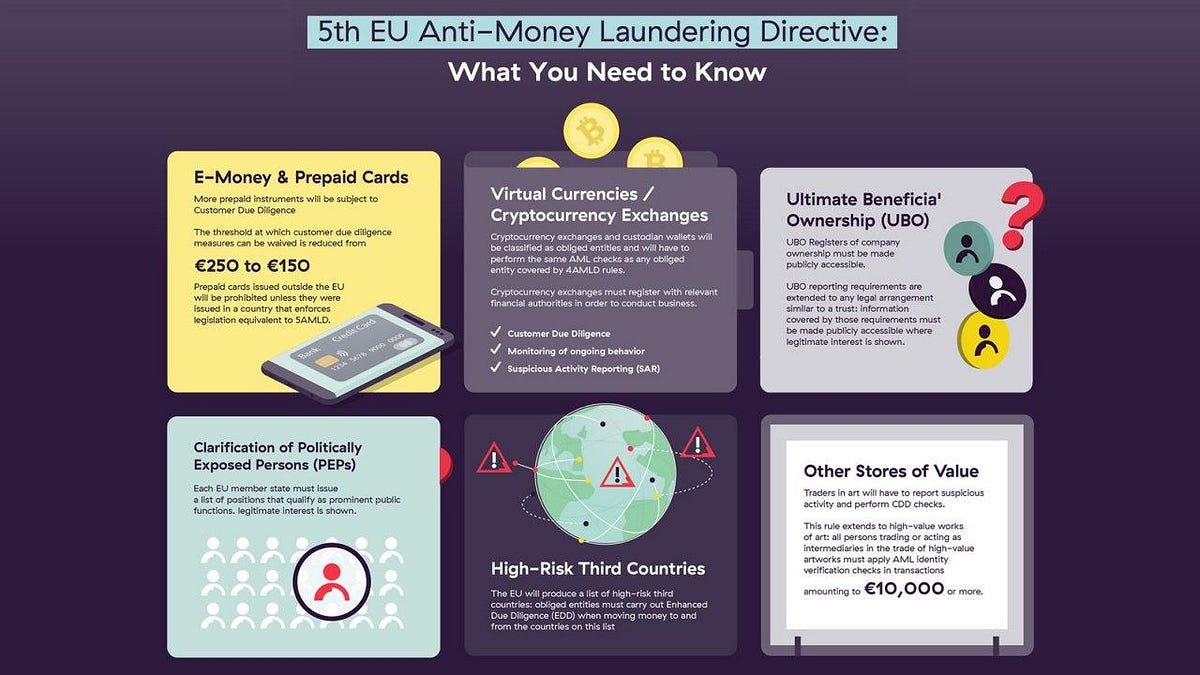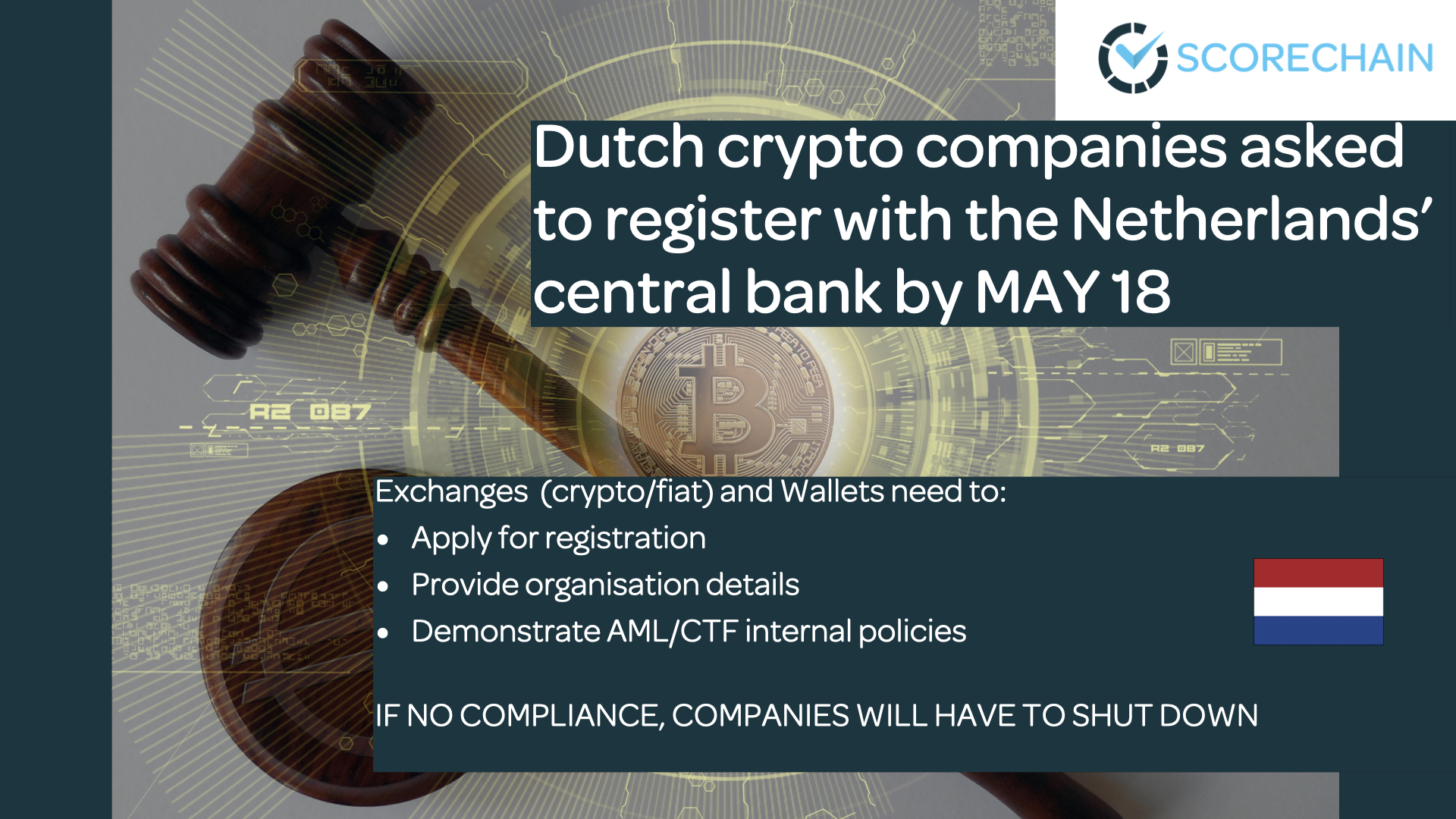Your 5th aml directive crypto images are available in this site. 5th aml directive crypto are a topic that is being searched for and liked by netizens now. You can Find and Download the 5th aml directive crypto files here. Find and Download all royalty-free photos and vectors.
If you’re searching for 5th aml directive crypto pictures information connected with to the 5th aml directive crypto topic, you have visit the ideal site. Our website frequently provides you with hints for downloading the highest quality video and picture content, please kindly hunt and find more informative video content and graphics that match your interests.
5th Aml Directive Crypto. A legal definition of cryptocurrency which may broadly be regarded as a digital representation. If playback doesnt begin shortly try restarting your device. Application of AML legislation to crypto currency exchanges and wallets. In this video Verity Snelson Risk Intelligence Manager at Refinitiv takes a look at the EU Fifth AML Directive and what that means for the Cryptocurrency sector.
 The 2021 Guide To Aml And Kyc For Crypto Exchanges Wallets Getid From getid.ee
The 2021 Guide To Aml And Kyc For Crypto Exchanges Wallets Getid From getid.ee
In January 2020 the EUs fifth Anti-Money Laundering Directive 5MLD came into force expanding the sectors that will now become obliged entities to include Virtual Assets and Virtual Asset Service providers otherwise known as Cryptoasset businesses. Therefore cryptocurrency operators will have to adopt a number of measures in order to comply with the requirements of the directive as they are now considered to be liable. The 5th AML Directive April 9 2019 in Blog Post 3963 Views On the 9 th June 2018 the EU Commission brought crypto-fiat exchanges and custodian wallets under the anti-money laundering regulation vide the Fifth Anti-Money Laundering Directive 5MLD. A digital representation of value that is not issued or guaranteed by a central bank or a public authority is not necessarily attached to a legally established currency and does not possess a legal status of currency or. Application of AML legislation to crypto currency exchanges and wallets. The introduction of the 5th AML Directive which constitutes a key development and a uniform framework for regulators across the EU exemplifies this effort to bring cryptocurrency activities within the regulatory ambit by introducing relevant provisions and imposing relevant obligations to certain cryptocurrency providers and activities.
The fifth directive names cryptocurrency as virtual currency and defines them as follows.
1 Directive EU 2015849 of the European Parliament and of the Council 4 constitutes the main legal instrument in the prevention of the use of the Union financial system for the purposes of money laundering and terrorist financing. The fifth directive names cryptocurrency as virtual currency and defines them as follows. A digital representation of value that is not issued or guaranteed by a central bank or a public authority is not necessarily attached to a legally established currency and does not possess a legal status of currency or. The 5th AML Directive aimed to add an element of regulation to cryptocurrencies and persons who use them. With the 5th Anti Money Laundering Directive coming into force in country members of the European Union we can see the crypto sphere has passed a crucial milestone from a regulation perspective. Effective anti-money laundering legislation requires so called obliged entities to comply with extended due diligence obligations when establishing and performing.
 Source: blog.scorechain.com
Source: blog.scorechain.com
Although much of 5MLDs content updates the 4MLD it makes a significant new legislative step in the treatment of virtual currencies. Videos you watch may be added to the TVs watch history and influence TV recommendations. Application of AML legislation to crypto currency exchanges and wallets. The 5AMLD was proposed by the European Commission in 2018 following the Panama Papers revelations and several terrorist attacks that took place in. In January 2020 the EUs fifth Anti-Money Laundering Directive 5MLD came into force expanding the sectors that will now become obliged entities to include Virtual Assets and Virtual Asset Service providers otherwise known as Cryptoasset businesses.
 Source: ico.li
Source: ico.li
If playback doesnt begin shortly try restarting your device. Application of AML legislation to crypto currency exchanges and wallets. If playback doesnt begin shortly try restarting your device. The 5th Anti-Money Laundering Directive and What It Means for Crypto Businesses 14 mrt The 5th Anti-Money Laundering Directive and What It Means for Crypto Businesses Proposed in July 2016 as part of the EUs plans to combat terrorism the 5th EU Anti-Money Laundering Directive AMLD 5 entered into force on the 9th of July 2018. AML guidelines for regulatory compliance of cryptocurrency businesses in the European Union.
 Source: coinfirm.com
Source: coinfirm.com
The 5th AML Directive aimed to add an element of regulation to cryptocurrencies and persons who use them. A digital representation of value that is not issued or guaranteed by a central bank or a public authority is not necessarily attached to a legally established currency and does not possess a legal status of currency or. A legal definition of cryptocurrency which may broadly be regarded as a digital representation. Although much of 5MLDs content updates the 4MLD it makes a significant new legislative step in the treatment of virtual currencies. To avoid this cancel and sign in to YouTube on your computer.
 Source: complyadvantage.com
Source: complyadvantage.com
The fifth directive names cryptocurrency as virtual currency and defines them as follows. With the 5th Anti Money Laundering Directive coming into force in country members of the European Union we can see the crypto sphere has passed a crucial milestone from a regulation perspective. 5AMLD 5th Anti-Money Laundering Directive. Effective anti-money laundering legislation requires so called obliged entities to comply with extended due diligence obligations when establishing and performing. The legislation known as the 5th Anti-Money Laundering Directive marks a key development in cryptocurrency regulation with the worlds second largest economy now providing clarity to cryptocurrency businesses on their anti-money laundering AML and counter-terrorism financing CTF obligations.
 Source: id.pinterest.com
Source: id.pinterest.com
It was first published on June 19th 2018 in the Official Journal of the European Union as an iteration of the 4th Anti-Money Laundering Directive AMLD4. The legislation known as the 5th Anti-Money Laundering Directive marks a key development in cryptocurrency regulation with the worlds second largest economy now providing clarity to cryptocurrency businesses on their anti-money laundering AML and counter-terrorism financing CTF obligations. Data feed on superior crypto tracker Whale alert revealed whales moved 935746 ETH value 255458658 in eight transactions within minutes exhibiting a large number of transactions happening within the Ethereum. Videos you watch may be added to the TVs watch history and influence TV recommendations. To avoid this cancel and sign in to YouTube on your computer.
 Source: bitquery.io
Source: bitquery.io
EU Fifth AML Directive compliance for Cryptocurrency sector. Effective anti-money laundering legislation requires so called obliged entities to comply with extended due diligence obligations when establishing and performing. The fifth directive names cryptocurrency as virtual currency and defines them as follows. The 5AMLD was proposed by the European Commission in 2018 following the Panama Papers revelations and several terrorist attacks that took place in. The 5th AML Directive will effectively bring the.
 Source: getid.ee
Source: getid.ee
The 5th Anti-Money Laundering Directive AMLD5 is an update to the European Unions anti-money laundering AML legal framework. In more detail 5MLD introduces the following measures. The 5th AML Directive will effectively bring the. 5MLD obliges Cryptoasset businesses to implement robust risk-based policies and procedures to comply with Anti-Money. With the 5th Anti Money Laundering Directive coming into force in country members of the European Union we can see the crypto sphere has passed a crucial milestone from a regulation perspective.
 Source: pinterest.com
Source: pinterest.com
The 5th AML Directive will effectively bring the. The fifth directive names cryptocurrency as virtual currency and defines them as follows. In more detail 5MLD introduces the following measures. A legal definition of cryptocurrency which may broadly be regarded as a digital representation. The 5th AML Directive will effectively bring the.
 Source: medium.com
Source: medium.com
A legal definition of cryptocurrency which may broadly be regarded as a digital representation. Videos you watch may be added to the TVs watch history and influence TV recommendations. The 5th AML Directive April 9 2019 in Blog Post 3963 Views On the 9 th June 2018 the EU Commission brought crypto-fiat exchanges and custodian wallets under the anti-money laundering regulation vide the Fifth Anti-Money Laundering Directive 5MLD. To avoid this cancel and sign in to YouTube on your computer. Although much of 5MLDs content updates the 4MLD it makes a significant new legislative step in the treatment of virtual currencies.
 Source: thepaypers.com
Source: thepaypers.com
A week later the EUs 5th AML Directive came into force which obligated the crypto market and EU participants working in the EU and UK to authenticate users track transactions and report. The 5th Anti-Money Laundering Directive AMLD5 is an update to the European Unions anti-money laundering AML legal framework. Cryptocurrencies and AMLD 5. To avoid this cancel and sign in to YouTube on your computer. A digital representation of value that is not issued or guaranteed by a central bank or a public authority is not necessarily attached to a legally established currency and does not possess a legal status of currency or.
 Source: ar.pinterest.com
Source: ar.pinterest.com
1 Directive EU 2015849 of the European Parliament and of the Council 4 constitutes the main legal instrument in the prevention of the use of the Union financial system for the purposes of money laundering and terrorist financing. That Directive which had a transposition deadline of 26 June 2017 sets out an efficient and comprehensive legal framework for addressing the collection of. 1 Directive EU 2015849 of the European Parliament and of the Council 4 constitutes the main legal instrument in the prevention of the use of the Union financial system for the purposes of money laundering and terrorist financing. The 5th AML Directive April 9 2019 in Blog Post 3963 Views On the 9 th June 2018 the EU Commission brought crypto-fiat exchanges and custodian wallets under the anti-money laundering regulation vide the Fifth Anti-Money Laundering Directive 5MLD. The 5th AML Directive aimed to add an element of regulation to cryptocurrencies and persons who use them.
 Source: blog.scorechain.com
Source: blog.scorechain.com
AMLD5 for cryptocurrency business The 5th Directive makes the legal situation on the cryptocurrency market more transparent helping entrepreneurs to obtain the necessary clarity of crypto transactions that is required to prevent money laundering and terrorist financing. The introduction of the 5th AML Directive which constitutes a key development and a uniform framework for regulators across the EU exemplifies this effort to bring cryptocurrency activities within the regulatory ambit by introducing relevant provisions and imposing relevant obligations to certain cryptocurrency providers and activities. A digital representation of value that is not issued or guaranteed by a central bank or a public authority is not necessarily attached to a legally established currency and does not possess a legal status of currency or. Application of AML legislation to crypto currency exchanges and wallets. Effective anti-money laundering legislation requires so called obliged entities to comply with extended due diligence obligations when establishing and performing.
 Source: coinfirm.com
Source: coinfirm.com
Although much of 5MLDs content updates the 4MLD it makes a significant new legislative step in the treatment of virtual currencies. The 5th Anti-Money Laundering Directive and What It Means for Crypto Businesses 14 mrt The 5th Anti-Money Laundering Directive and What It Means for Crypto Businesses Proposed in July 2016 as part of the EUs plans to combat terrorism the 5th EU Anti-Money Laundering Directive AMLD 5 entered into force on the 9th of July 2018. Therefore cryptocurrency operators will have to adopt a number of measures in order to comply with the requirements of the directive as they are now considered to be liable. Effective anti-money laundering legislation requires so called obliged entities to comply with extended due diligence obligations when establishing and performing. AML guidelines for regulatory compliance of cryptocurrency businesses in the European Union.
This site is an open community for users to share their favorite wallpapers on the internet, all images or pictures in this website are for personal wallpaper use only, it is stricly prohibited to use this wallpaper for commercial purposes, if you are the author and find this image is shared without your permission, please kindly raise a DMCA report to Us.
If you find this site value, please support us by sharing this posts to your preference social media accounts like Facebook, Instagram and so on or you can also bookmark this blog page with the title 5th aml directive crypto by using Ctrl + D for devices a laptop with a Windows operating system or Command + D for laptops with an Apple operating system. If you use a smartphone, you can also use the drawer menu of the browser you are using. Whether it’s a Windows, Mac, iOS or Android operating system, you will still be able to bookmark this website.






